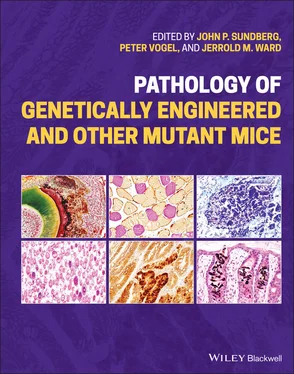Pathology of Genetically Engineered and Other Mutant Mice
Здесь есть возможность читать онлайн «Pathology of Genetically Engineered and Other Mutant Mice» — ознакомительный отрывок электронной книги совершенно бесплатно, а после прочтения отрывка купить полную версию. В некоторых случаях можно слушать аудио, скачать через торрент в формате fb2 и присутствует краткое содержание. Жанр: unrecognised, на английском языке. Описание произведения, (предисловие) а так же отзывы посетителей доступны на портале библиотеки ЛибКат.
- Название:Pathology of Genetically Engineered and Other Mutant Mice
- Автор:
- Жанр:
- Год:неизвестен
- ISBN:нет данных
- Рейтинг книги:3 / 5. Голосов: 1
-
Избранное:Добавить в избранное
- Отзывы:
-
Ваша оценка:
- 60
- 1
- 2
- 3
- 4
- 5
Pathology of Genetically Engineered and Other Mutant Mice: краткое содержание, описание и аннотация
Предлагаем к чтению аннотацию, описание, краткое содержание или предисловие (зависит от того, что написал сам автор книги «Pathology of Genetically Engineered and Other Mutant Mice»). Если вы не нашли необходимую информацию о книге — напишите в комментариях, мы постараемся отыскать её.
An updated and comprehensive reference to pathology in every organ system in genetically modified mice Pathology of Genetically Engineered and Other Mutant Mice
Pathology of Genetically Engineered and Other Mutant Mice
Pathology of Genetically Engineered and Other Mutant Mice — читать онлайн ознакомительный отрывок
Ниже представлен текст книги, разбитый по страницам. Система сохранения места последней прочитанной страницы, позволяет с удобством читать онлайн бесплатно книгу «Pathology of Genetically Engineered and Other Mutant Mice», без необходимости каждый раз заново искать на чём Вы остановились. Поставьте закладку, и сможете в любой момент перейти на страницу, на которой закончили чтение.
Интервал:
Закладка:
99 99 Zou, X., Bolon, B., Pretorius, J.K. et al. (2009). Neonatal death in mice lacking cardiotrophin‐like cytokine (CLC) is associated with multifocal neuronal hypoplasia. Vet. Pathol. 46 (3): 514–519.
100 100 Tamura, K., Sudo, T., Senftleben, U. et al. (2000). Requirement for p38a in erythropoietin expression: a role for stress kinases in erythropoiesis. Cell 102 (2): 221–231.
101 101 Withington, S.L., Scott, A.N., Saunders, D.N. et al. (2006). Loss of Cited2 affects trophoblast formation and vascularization of the mouse placenta. Dev. Biol. 294 (1): 67–82.
6 Ciliopathies
Peter Vogel and Laura J. Janke
Introduction
Cilia are exceptionally complex microtubule‐based organelles that are present on the surface of almost every type of cell as either multiple motile cilia or individual nonmotile primary/sensory cilia. Dysfunctional cilia result in diseases termed ciliopathies, the number of which is continually increasing. Research on genetically engineered mice is facilitating the discovery of novel ciliopathies and the functions of the ciliary proteins involved [1]. Primary/sensory cilia are present on almost all cell types, whereas motile cilia are generally restricted to the respiratory tract, ependymal cells in the brain, reproductive tract, and the embryonic node. Primary/sensory cilia play key roles in a wide range of developmental and cellular functions, including cell‐cycle regulation and planar cell polarity, as well as photo‐, mechano‐, and chemo‐sensation. Motile cilia move fluids over epithelial surfaces and as flagella, propel spermatozoa. The sensory cilia integrate critical signaling pathways involved in development and differentiation, with the sensory primary cilium essentially acting as a cell antenna that contains and integrates critical components of the sonic hedgehog (SHH), wingless‐type mouse mammary tumor virus (MMTV) integration site family (), Hippo, Notch, and mechanistic target of rapamycin kinase (mTOR) signaling pathways, among others [2]. For example, the hedgehog (HH) pathway is involved in the developmental patterning of many tissues, including the neural tube and limb buds [3], and defective HH signaling is strongly linked to the development of ciliopathies.
Given their nearly ubiquitous distribution and diverse functions, defects in proteins required for the biogenesis and/or function of these extremely complex multifunctional organelles have been linked to an ever expanding and heterogeneous group of inherited ciliopathies [4–6]. It is important for mouse pathologists to recognize the pleomorphic disease phenotypes that are indicative of a ciliary dysfunction because the pathologist is frequently the only research team member that evaluates the whole animal [7], and mutations affecting the several hundred genes involved in the biogenesis and function of cilia make ciliopathies surprisingly common.
The essential functions of cilia are reflected by the significant number of highly conserved genes in the ciliary proteome (ciliome). For example, many conserved structural and intraflagellar transport (IFT) proteins that are present in Chlamydomonas reinhardtii have made this single‐cell green algae a very useful model for identifying ciliary proteins and processes in motile cilia. In the evolution of multicellular animals, the sensory primary cilia provided the means of intercellular communication required to coordinate the growth, patterning, and differentiation of cells [8] and for sensing environmental stimuli [9]. The localization of HH, G protein‐coupled receptors (GPCRs), and transient receptor potential (TRP) channels to cilia began before the origin of animals [10]. The continually expanding ciliome includes over a thousand different proteins [11], and hundreds of these have already been localized to the ciliary/flagellar axoneme, ciliary root, centriole, basal body transition zone, IFT proteins, ciliary membrane, central pair, axoneme, or ciliary tip in humans and mice [12, 13].
These structures have specific functions within the cilium – the basal body is involved in early ciliogenesis, the transition zone functions in ciliary gating, and the IFT enables cargo trafficking and signaling. Some receptors and pathways are localized to one of these specific areas, whereas others affect multiple processes within the cilia. For example, the HH receptor Patched1 ( Ptch1 ) is located on primary cilia [14] and the levels of HH and other signaling molecules on the ciliary membrane are affected by both trafficking via IFT and gating at the transition zone. In addition, several so called second‐order ciliopathies have been identified; these are caused by dysfunction or loss of nonciliary proteins that are nevertheless required for ciliary biogenesis/function [15].
Although the cilium is contiguous with the rest of the cell, its contents and membrane must be functionally separate from the rest of the cell in order for it to function as a cellular antenna. To maintain the distinct compartmentalization of ciliary components, a specialized transition zone surrounding the base of the cilium controls which proteins can enter and exit the cilium, and also forms a diffusion barrier for membrane‐associated soluble proteins [16]. Numerous mutations affecting transitional zone proteins have been identified in both motile and nonmotile cilia.
Cilia can be classified on the basis of their number (multiple vs. single), their motility (motile vs. immotile), and by the presence or lack of central microtubule singlets within the core of the cilium (axoneme). In all cilia, the axoneme is made up of nine radially arranged microtubules that originate from the basal body. Motile cilia typically have two central microtubule singlets and axonemal inner and outer dynein arms that power ciliary movement, forming a 9 + 2 pattern. The motile cilia and flagella are responsible for sperm locomotion and the generation of extracellular fluid flow [17], whereas the nonmotile primary cilia are sensory, which requires the localization of specific signal transduction machinery to cilia [8]. In contrast, axonemes in nonmotile cilia lack the central pair and thus have a 9 + 0 arrangement of microtubules.
Identifying the pleomorphic phenotypes indicative of a ciliopathy requires careful examination of mice at time of necropsy and under the microscope. The ciliopathy‐associated phenotypes that are best identified grossly include hydrocephalus, craniofacial and skeletal defects, and laterality defects. Histology is used to identify lesions such as rhinosinusitis, otitis media, spermatozoal flagellar defects, and brain malformations. Other symptoms that may be the result of ciliary dysfunction include behavioral disorders, deafness, and obesity. However, since these disorders can have underlying pathogenetic mechanisms that do not involve cilia, they generally must be accompanied by one or more other cilia‐related phenotypes to be recognized as potential ciliopathies. Although motile and sensory cilia sometimes have overlapping effects on embryonic development or adult tissue homeostasis [5], the phenotypes of most ciliopathies are conveniently categorized as involving predominantly motile or sensory cilia.
Motile Ciliopathies
Motile cilia (including flagella) exhibit wave‐like or beating motions that are powered by the molecular motor dynein. Motile cilia are present in the respiratory tract, ependymal cells in the brain, reproductive tract, and embryo. While formation of a single cilium is a complex process depending on hundreds of proteins, multiciliated cells must develop a complex network of properly oriented cilia that beat in coordinated fashion in order to generate continuous fluid flow in the brain ventricles, nasal and pulmonary airways, oviduct/epididymis, and embryonic node. Defective motile cilia cause primary ciliary dyskinesias (PCDs), which are typically characterized by chronic rhinosinusitis, pulmonary infections, otitis media, impaired fertility, and hydrocephalus [18–20]. Interestingly, bronchiectasis and pulmonary infections are typical signs of motile ciliary defects in humans but these lesions are absent in mice, whereas hydrocephalus is rare in affected humans but common in mice [21]. Defective motile cilia in the embryonic node lead to laterality defects such as situs inversus and heterotaxy in both mice and humans [22]. Mutations in genes that encode axonemal dynein subunits and dynein motor assembly proteins account for fewer than two‐thirds of PCD cases, indicating that many motile cilia gene mutations causing these diseases remain to be discovered [23].
Читать дальшеИнтервал:
Закладка:
Похожие книги на «Pathology of Genetically Engineered and Other Mutant Mice»
Представляем Вашему вниманию похожие книги на «Pathology of Genetically Engineered and Other Mutant Mice» списком для выбора. Мы отобрали схожую по названию и смыслу литературу в надежде предоставить читателям больше вариантов отыскать новые, интересные, ещё непрочитанные произведения.
Обсуждение, отзывы о книге «Pathology of Genetically Engineered and Other Mutant Mice» и просто собственные мнения читателей. Оставьте ваши комментарии, напишите, что Вы думаете о произведении, его смысле или главных героях. Укажите что конкретно понравилось, а что нет, и почему Вы так считаете.












